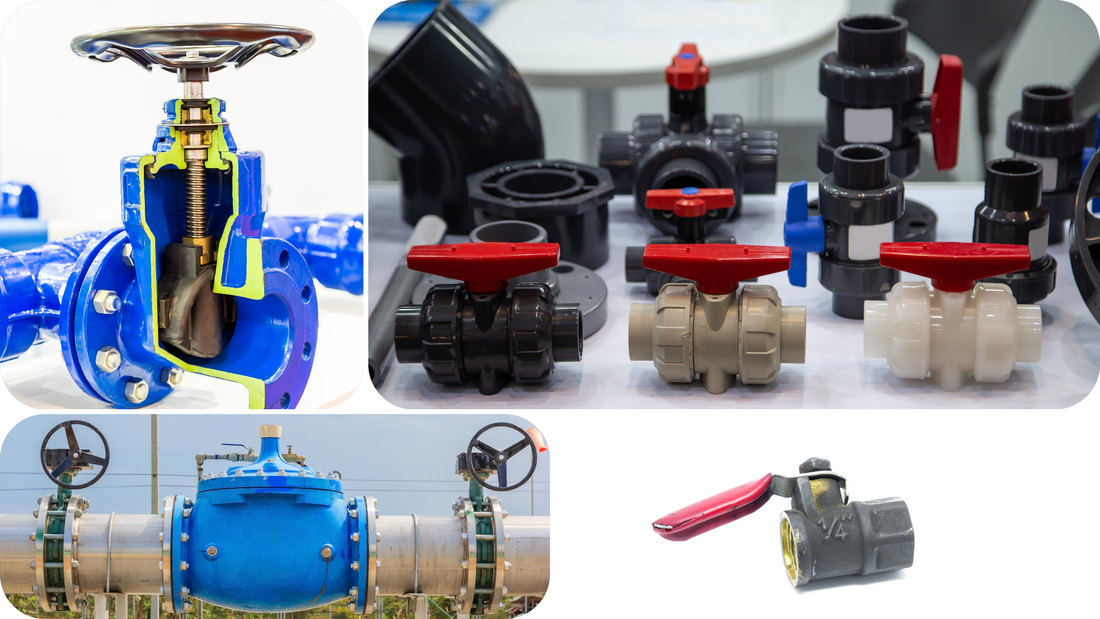
Overview: Common valve types used in industrial fluid handling and their applications.
Share
In industrial fluid handling, various types of valves are used to control, direct, and regulate fluid flow. The selection depends on factors like fluid type, pressure, temperature, and desired flow control. Here are some of the most commonly used valve types:
1. Gate Valves
- Description: Designed to start or stop flow; the gate lifts entirely out of the fluid path.
- Applications: Used in systems requiring minimal flow restriction.
- Pros: Low pressure drop when fully open; durable and reliable.
- Cons: Slow operation and not suitable for throttling.
2. Globe Valves
- Description: Has a spherical body and uses a movable disk to control flow.
- Applications: Suitable for throttling and flow regulation.
- Pros: Good for flow control; moderate seal.
- Cons: Higher pressure drop compared to gate valves.
3. Ball Valves
- Description: Uses a rotating ball with a hole through the center; provides quick on/off control.
- Applications: Often used in high-pressure and high-flow applications.
- Pros: Quick operation, tight sealing.
- Cons: Not ideal for throttling due to potential for uneven wear.
4. Butterfly Valves
- Description: Has a rotating disc that controls flow through a pipe.
- Applications: Common in large-diameter pipes and low-pressure applications.
- Pros: Lightweight, compact, easy to install.
- Cons: Less precise control; can create pressure drop when partially open.
5. Check Valves
- Description: Allows flow in one direction only, preventing backflow.
- Applications: Used in pump discharge lines and water/wastewater systems.
- Pros: Prevents reverse flow automatically; requires no manual operation.
- Cons: Limited control; not suitable for systems needing backflow.
6. Diaphragm Valves
- Description: Uses a flexible diaphragm that presses against a seat to control flow.
- Applications: Used in applications needing hygiene, such as pharmaceutical or food processing.
- Pros: Good for slurry or viscous fluids; leak-proof.
- Cons: Limited to low-pressure systems; slower operation.
7. Plug Valves
- Description: Features a tapered or cylindrical plug with a hole to control flow.
- Applications: Often used in on/off applications.
- Pros: Compact, quick operation.
- Cons: Not ideal for throttling; can be challenging to operate under high pressure.
8. Pressure Relief Valves
- Description: Automatically releases pressure when it exceeds a set limit.
- Applications: Protects systems from overpressure, common in gas, steam, and liquid lines.
- Pros: Provides critical safety.
- Cons: Not for flow regulation; only activates during overpressure.
9. Needle Valves
- Description: Has a small, needle-shaped plunger for precise flow control.
- Applications: Common in low-flow applications and instrumentation.
- Pros: Fine control over flow rates.
- Cons: Not ideal for high-flow applications due to its small size.
10. Cryogenic Valves
- Description: Specifically designed for extremely low temperatures.
- Applications: Used in industries like LNG, liquid nitrogen, and other cryogenic gases.
- Pros: Materials selected to withstand extreme cold; excellent sealing under low temperatures.
- Cons: Limited to cryogenic applications; high cost due to specialized materials.
11. Solenoid Valves
- Description: Operated by electromagnetic solenoids for fast, remote control.
- Applications: Common in automation, instrumentation, and HVAC systems.
- Pros: Fast, precise control; remotely operable; good for small-diameter applications.
- Cons: Require power supply; limited to lower flow and pressure.
12. Piston Valves
- Description: Uses a cylindrical piston to control flow by sliding it in or out of the path.
- Applications: Often found in steam systems or high-temperature applications.
- Pros: Excellent for high-temperature and high-pressure systems; tight sealing.
- Cons: Can require more maintenance; not ideal for corrosive fluids.
13. Knife Gate Valves
- Description: Designed with a sharp-edged gate that cuts through thick media.
- Applications: Ideal for handling slurry, sewage, or other heavy media.
- Pros: Works well with viscous and solid-laden fluids; low-cost.
- Cons: Not for high-pressure systems; prone to wear in abrasive applications.
14. Cartridge Valves
- Description: Small, modular valves that are inserted into a manifold for fluid control.
- Applications: Common in hydraulic systems and compact machinery.
- Pros: Space-saving, customizable; easy to replace without disturbing the system.
- Cons: Limited in size and flow capacity; complex manifolds can be challenging to design.
15. Choke Valves
- Description: Designed to reduce pressure and control flow, typically in high-pressure applications.
- Applications: Primarily used in the oil and gas industry, especially in wellheads.
- Pros: Excellent for pressure reduction; good for high-pressure, high-wear environments.
- Cons: Can be noisy; subject to erosion from abrasive particles.
16. Vacuum Valves
- Description: Specifically built to handle systems under vacuum.
- Applications: Used in semiconductor manufacturing, lab equipment, and vacuum pumps.
- Pros: Maintains tight seals even under low pressures; prevents air contamination.
- Cons: Limited to vacuum or low-pressure applications; specialized construction can be costly.
17. Pressure Reducing Valves
- Description: Automatically lowers and maintains downstream pressure.
- Applications: Common in water supply systems, compressed air, and gas lines.
- Pros: Protects equipment from overpressure; maintains consistent flow.
- Cons: Only reduces pressure; not suitable for stopping flow.
18. Hydraulic Control Valves
- Description: Operated by hydraulic pressure rather than manual or electric actuation.
- Applications: Common in hydraulic power systems for machinery and heavy equipment.
- Pros: High power-to-weight ratio; precise control.
- Cons: Requires hydraulic fluid supply; sensitive to fluid contamination.
Each valve types serves a unique purpose, so choosing the right valve depends on the specify requirements of the industrial fluid system. The less common valves mentioned here often fill highly specialized roles in industrial system, providing targeted control solutions in complex end use applications or challenging environments.